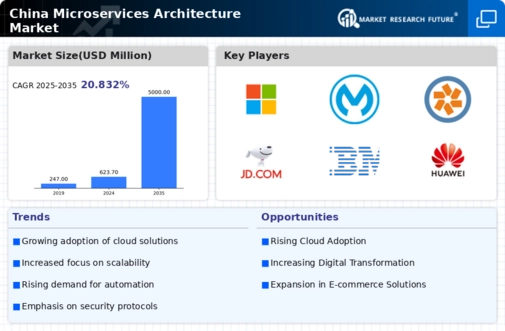Growing Demand for Scalability
the microservices architecture market is experiencing a notable surge in demand for scalability solutions. As businesses expand, they require systems that can efficiently handle increased workloads. Microservices architecture allows organizations to develop applications in a modular fashion, enabling them to scale individual components independently. This flexibility is particularly appealing to Chinese enterprises aiming to enhance their operational efficiency. According to recent data, the scalability aspect of microservices is projected to contribute to a growth rate of approximately 25% in the market by 2026. This trend indicates a strong preference for architectures that can adapt to fluctuating demands, thereby driving the microservices architecture market forward.
Increased Focus on Cost Efficiency
Cost efficiency remains a critical driver for the microservices architecture market. Organizations are continually seeking ways to optimize their IT expenditures while maintaining high performance. Microservices architecture allows for the deployment of lightweight services that can be managed more cost-effectively compared to traditional monolithic systems. This approach not only reduces operational costs but also enhances resource utilization. Recent analyses suggest that companies adopting microservices can achieve up to 30% savings in operational costs. This financial incentive is likely to encourage more businesses in China to transition towards microservices, thereby expanding the market.
Enhanced Collaboration and Innovation
the microservices architecture market is also being propelled by the need for enhanced collaboration and innovation within organizations. By breaking down applications into smaller, manageable services, teams can work concurrently on different components, fostering a culture of innovation. This collaborative environment is essential for companies aiming to stay competitive in a rapidly evolving market. Furthermore, the microservices architecture supports the integration of emerging technologies such as AI and IoT, which are gaining traction in China. This synergy between microservices and innovative technologies is likely to drive further growth in the microservices architecture market.
Regulatory Compliance and Data Sovereignty
In the context of the microservices architecture market, regulatory compliance and data sovereignty are becoming increasingly important. As the government enforces stricter data protection laws, organizations must ensure that their IT architectures comply with these regulations. Microservices architecture offers the flexibility to implement compliance measures at a granular level, allowing businesses to manage data in accordance with local laws. This adaptability is crucial for companies operating in China, where data sovereignty is a significant concern. The emphasis on compliance is expected to drive the adoption of microservices, as organizations seek to align their IT strategies with regulatory requirements.
Rise of Digital Transformation Initiatives
In China, the ongoing digital transformation initiatives across various sectors are significantly influencing the microservices architecture market. Organizations are increasingly adopting digital technologies to improve customer experiences and operational efficiencies. The microservices architecture facilitates this transformation by enabling rapid development and deployment of applications. As per industry reports, around 70% of Chinese companies are investing in digital transformation, which is expected to bolster the microservices architecture market. This shift towards digital solutions indicates a growing recognition of the need for agile and responsive IT infrastructures, further propelling the adoption of microservices.

















Leave a Comment